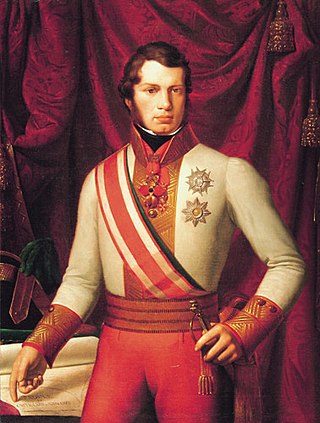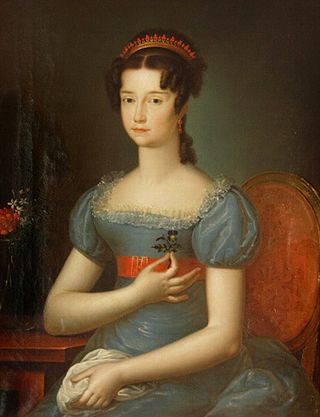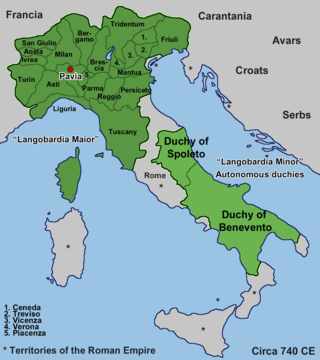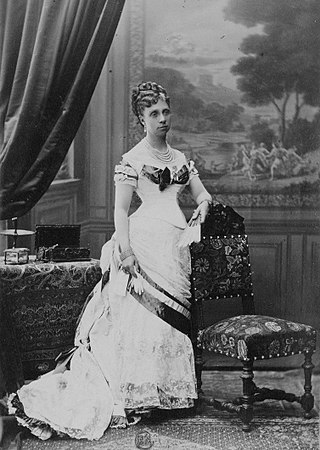
Lucca is a city and comune in Tuscany, Central Italy, on the Serchio River, in a fertile plain near the Ligurian Sea. The city has a population of about 89,000, while its province has a population of 383,957.
This article deals with the history of Tuscany.

Leopold II was Grand Duke of Tuscany from 1824 to 1859. He married twice; first to Maria Anna of Saxony, and after her death in 1832, to Maria Antonia of the Two-Sicilies. By the latter, he begat his eventual successor, Ferdinand. Leopold was recognised contemporarily as a liberal monarch, authorising the Tuscan Constitution of 1848, and allowing a degree of press freedom.

The Duchy of Parma and Piacenza was an Italian state created in 1545 and located in northern Italy, in the current region of Emilia-Romagna.

The Grand Duchy of Tuscany was an Italian monarchy that existed, with interruptions, from 1569 to 1860, replacing the Republic of Florence. The grand duchy's capital was Florence. In the 19th century the population of the Grand Duchy was about 1,815,000 inhabitants.

The Kingdom of Etruria was an Italian kingdom between 1801 and 1807 that made up a large part of modern Tuscany. It took its name from Etruria, the old Roman name for the land of the Etruscans.

Charles III was the duke of Parma from 1849 to 1854.

Charles Louis was King of Etruria, Duke of Lucca, and Duke of Parma.

Louis I was the first of the two kings of Etruria. Louis was the son of Ferdinand, Duke of Parma, and Maria Amalia of Austria. He was born in 1773, when his great-grandfather, King Louis XV of France, was still alive.

Infanta Maria Luisa of Spain was Holy Roman Empress, German Queen, Queen of Hungary and Bohemia, and Grand Duchess of Tuscany as the spouse of Leopold II, Holy Roman Emperor.

Maria Luisa of Spain was a Spanish infanta, daughter of King Charles IV and his wife, Maria Luisa of Parma. In 1795, she married her first cousin Louis, Hereditary Prince of Parma. She spent the first years of her married life at the Spanish court where their first child, Charles, was born.

The use of capital punishment in Italy has been banned since 1889, with the exception of the period 1926–1947, encompassing the rule of Fascism in Italy and the early restoration of democracy. Before the unification of Italy in 1860, capital punishment was performed in almost all pre-unitarian states, except for Tuscany, where, starting from 1786, it was repeatedly abolished and reintroduced. It is currently prohibited by the Constitution of the Italian Republic with no more exceptions even in times of war.

Louise Marie Thérèse d'Artois was a duchess and later a regent of Parma. She was the eldest daughter of Charles Ferdinand, Duke of Berry, younger son of King Charles X of France and Princess Caroline of Naples and Sicily. She served as regent of Parma during the minority of her son from 1854 until 1859.

Maria Teresa of Savoy was Duchess consort of Parma and Piacenza by marriage to Charles II, Duke of Parma.

The House of Bourbon-Parma is a cadet branch of the Spanish royal family, whose members once ruled as King of Etruria and as Duke of Parma and Piacenza, Guastalla, and Lucca. The House descended from the French Capetian dynasty in male line. Its name of Bourbon-Parma comes from the main name (Bourbon) and the other (Parma) from the title of Duke of Parma. The title was held by the Spanish Bourbons, as the founder Philip, Duke of Parma was the great-grandson of Ranuccio II Farnese, Duke of Parma. The House of Bourbon-Parma is today the Sovereign House of the Grand Duchy of Luxembourg (agnatically) and all members of the Grand Ducal Family of Luxembourg are members of the House of Bourbon-Parma with the title of "Princes/Princesses" and the predicate of Royal Highness.

The Duchy of Tuscia, initially known as the Duchy of Lucca, was a Lombard duchy in Central Italy, which included much of today's Tuscany. After the occupation of the territories belonging to the Byzantines, the Lombards founded this flourishing duchy which, among other centres, also included Florence. The capital of the duchy was Lucca, which was located along the Via Francigena, being also the city where the dukes resided.

Princess Margherita of Bourbon-Parma was the eldest child and daughter of Charles III, Duke of Parma and Princess Louise Marie Thérèse of France, the eldest daughter of Charles Ferdinand, Duke of Berry and Princess Caroline Ferdinande Louise of the Two Sicilies.

The Principality of Lucca and Piombino was created in July 1805 by Napoleon I for his sister Elisa Bonaparte. It was a state located on the central Italian Peninsula and was a client state of Napoleonic France.

The flag of Tuscany is the official flag of the region of Tuscany, Italy. The flag depicts a silver Pegasus rampant on a white field between two horizontal red bands. The flag first appeared as a gonfalon on 20 May 1975 along with accompanying text Regione Toscana above the Pegasus. It was officially adopted as the flag of Tuscany on 3 February 1995.

Tenuta Reale was a landed property, located at the outskirts of Viareggio, Italy. It was carved out as private estate in the 1810s, when it covered few hundred hectares; over time its size diminished due to expropriations and sales of various plots. Tenuta belonged to the ducal family of House of Bourbon-Parma and its descendants, since the 1890s married to the Habsburg-Lothringens; in 1985 its remains were donated to the municipality of Viareggio. The centre of the estate was a large mansion known as Villa Borbone; it forms part of local architectural heritage, and its most recognized part is the sepulchral chapel, which hosts remnants of various historical personalities. The past of Tenuta Reale is at the crossroads of national histories of Italy, Spain and Austria; its other peculiarity is that it is related almost exclusively to female owners and was shaped by numerous women. The Villa currently is open to public and hosts exhibitions, conferences, concerts etc.































